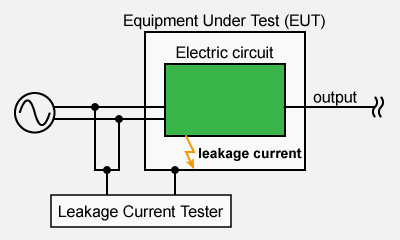Leakage current is a small amount of electrical current that flows through unintended paths in an electronic circuit, typically where insulation is intended to prevent such flow. The term "electrical leakage" is often used in a similar context, sometimes referring to more general instances of current escaping its intended path.
It's important to distinguish between different types of leakage currents:
1. Component-level leakage: This includes minute currents inherently present within electronic components like semiconductors (e.g., due to quantum tunneling) or capacitors. While undesirable, these are often an intrinsic characteristic of the component.
2. Operational leakage current (or protective conductor current): This is the current that flows from an electronic device to the protective earth ground during normal operation, typically through EMI filter capacitors. This current can pose a shock hazard if it finds a path through a person touching the device's conductive chassis, which is why safety standards strictly limit its maximum allowable value.
3. Fault current: This refers to a significantly larger current that flows due to a failure in insulation, a short circuit, or a ground fault. This is an abnormal and dangerous condition, distinct from the small, expected leakage currents.
In power supplies, leakage current primarily arises from two sources: parasitic capacitance and EMI filtering components. Parasitic capacitance, such as that between the primary and secondary windings of a transformer, creates an unintended path for current. More significantly, Y-capacitors within the input EMI (Electromagnetic Interference) filter are a major contributor. These capacitors are intentionally designed to shunt high-frequency noise from the power line to the earth ground. While essential for noise suppression, this design creates a direct path for a small amount of AC current to leak to the ground, which constitutes the bulk of the operational leakage current in a typical power supply.
For power supply manufacturers, "leakage current" almost always refers to this operational leakage current, which must be managed within strict safety limits. Controlling this leakage is critical, as excessive levels can lead to equipment malfunctions, increased power consumption, and component deterioration. It is distinct from a fault current, which is a much larger and more dangerous flow of current resulting from insulation failure that can cause severe circuit damage or electrical shock.
Because this current is limited by safety regulations in most countries, measuring leakage current accurately is critical. The measurement setup, often defined by safety standards (like IEC 60990), simulates the impedance of the human body to determine the potential current flow. The diagram below shows a simplified example of how leakage current measurement is performed.

Information on related articles in Technical Knowledge
- What is a Power Supply? Types and Applications
- What is a Power Supply? (Basic Knowledge)
- Safety and Usage of High Voltage Power Supply
- An Introduction to DC Power Supplies
- What is a Bipolar Power Supply? (Basic Knowledge)
- Electronic Loads: An Introduction to Principles, Types, and Uses
- What is AC Power Source? - Basic Knowledge -
- Linear vs. Switching Power Supplies: Key Differences Explained
- Types of X-ray Tubes and High-voltage Power Supplies
- High Voltage Measurement Method
- How to Choose a DC Power Supply: Key Points to Consider
- Difference between DC power and AC power
- A Beginner's Guide to Using Power Supplies Safely
- A Guide to Using DC Power Supplies Correctly and Safely
- HVPS for Lab Analyzers: Key Considerations for Stability and Noise
- Amplifier Basics: Principles, Operation, and Key Considerations
- Method of Generating Direct Current (DC) Power


